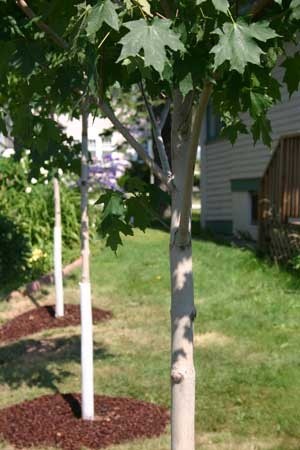
According to the Department of Energy, strategic planting of as few as three trees can provide the average household with an energy savings of between $100-$250 annually. It may be the best long-term investment for reducing heating and cooling costs.
Your overall approach to saving energy with trees depends largely on your geographical location.
Temperate Climates: Maximize the sun's warmth in the winter while utilizing shade in the summer. Protect buildings from wind in the winter and funnel breezes toward them in t he summer.
Hot-Arid Climates: Provide roofs, walls and windows with shade and utilize evapotranspiration (the process by which trees and plants move and releases water vapor) to cool the air around buildings in the summer. Block or deflect winds away from homes that are air-conditioned.
Hot-Humid Climates: Summer breezes should be channeled toward homes in hot-humid climates. Trees should be planted to maximize shade in summer and allow the penetration of low-angle sun in the winter. Avoid locating planting beds too close to the home if they require frequent watering.
Cool Climates: Construct windbreaks to shelter homes from cold winter winds. Plant trees so the low-angled winter sun can reach south facing windows in the winter, and still shade south and west windows from direct sun in the summer to avoid overheating.
Create Summer Shade & Capture Winter SunPlanting trees directly south of a home is not a good idea for energy savings. During summer months in the northern hemisphere, the sun is high in the sky at midday. The shadow cast by a tree will fall directly under the it and miss a home to its north entirely. In winter, the low angle of the sun will cause the tree's shadow to fall directly on the house, cooling it the entire day. Therefore, the best place to plant trees for shade is on the west (best) and east (second best) sides of the house.
Trees near the southeast and southwest ends of the home should have their lower branches pruned to allow in more winter sun. Trees can be planted within 20ft of the window and should optimally grow 10ft taller than window height. To avoid shading south windows, trees on the south side of the house should be planted at least twice their mature height away from the house.
Shading air conditioning units can increase their efficiency by up to 10%. Trees, shrubs and groundcover can also be planted around parking places and paved areas to cool the air before it reaches windows and walls.
Planting the Right Trees
Deciduous (leaf-dropping) trees are the most solar-friendly trees. Properly placed, their leaves provide shade in the summer and their leafless branches allow the warmth of the low-angled sun to penetrate in the winter.
The shape of a tree is another important consideration. A broader crowned tree casts a much larger shadow than a pyramidal shaped tree of the same height. Ask your nursery which types of trees native to your area would make good candidates.
Creating Windbreaks & Wind Deflectors
Windbreaks: To provide protection from cold winter winds, you need to plant the right amount of dense, tall trees clustered together. Evergreens make ideal trees for windbreaks because their branches are dense and extend all the way to the ground, and they grow tall enough to guide the wind over most buildings. Plant them in rows perpendicular to the primary winter wind direction-usually the west and north sides of a property. To keep dense branches growing near the ground, evergreens need full sun. Don't overcrowd them. Wind increases at the edge of a windbreak, so trees need to be taller and longer than the buildings being sheltered.
Wind Deflectors: Thick rows of trees and shrubs should be planted in such a way as to deflect cooling breezes into the rooms of your house. For example, if cool breezes come from the North, planting a row of thick, tall trees near the rear of the east side of your house and near the front of the west side of your house will actually create a wind funnel from east to west.
Trees do a lot more than help you lower your energy costs and provide birds with a place to perch. Tree-canopied neighborhoods keep average air temperatures dramatically cooler in the summer, which allows fewer air pollutants to form-creating cleaner, more comfortable places for people to live.

About The Author: Ellen Brown is an environmental writer and photographer and the owner of Sustainable Media, an environmental media company that specializes in helping businesses and organizations promote eco-friendly products and services. Contact her on the web at http://www.sustainable-media.com
Add your voice! Click below to comment. ThriftyFun is powered by your wisdom!

To cut energy bills and help save the environment, plant a tree. Planting trees provides an all-around environmental boost. Trees and other landscaping harbor wildlife, improve air quality and can save up to 30% in home heating and cooling costs. You may think planting is for spring, but fall is a great time to plant evergreen and deciduous trees and shrubs.
By Kathy
" Shading air conditioning units can increase their efficiency by up to 10%. Trees, shrubs and ground cover can also be planted around parking places and paved areas to cool the air before it reaches windows and walls."
I need a reference for this 10% increase in efficiency . Plz list ref or email aradhwan AT gmail.com
Great ideas! Thanks
Add your voice! Click below to comment. ThriftyFun is powered by your wisdom!